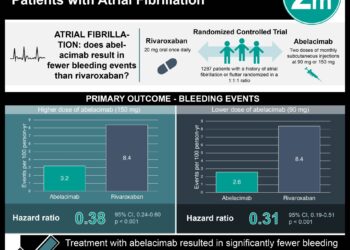2 Minute Medicine Rewind April 29, 2019
Alzheimer disease (AD) is characterized by the accumulation of amyloid b (Ab) and tau aggregates in the brain. The progression of AD can be monitored through imaging techniques or through the use of cerebrospinal fluid (CSF) biomarkers. As these modalities are expensive and invasive, an alternative method is needed. Neurofilament light (NfL) in the CSF is a biomarker for neuroaxonal damage, and recent developments have facilitated measurement of NfL in blood samples. In this cohort study, longitudinal plasma NfL levels were tested in 1,182 patients with mild cognitive impairment or AD dementia to investigate possible associations with other hallmarks of AD, such as CSF Ab and tau, imaging measures, and scores on cognitive tests. At baseline, 855 patients had mild cognitive impairment, and 327 patients had AD dementia. The analysis also included 401 patients who were cognitively unimpaired. Researchers found that the NfL level was increased at baseline in patients with mild cognitive impairment (mean level 37.9 ng/L) and AD dementia (mean level 45.9 ng/L) as compared to those who were cognitively unimpaired (mean level 32.1 ng/L) (p<0.001). Researchers also found that a longitudinal increase in NfL level correlated with baseline CSF biomarkers, including low Aβ42 (p=0.001), high total tau (p=0.02), and high phosphorylated tau levels (p=0.02). A longitudinal increase in NfL level also correlated with magnetic resonance imaging measures (small hippocampal volumes (p<0.001), thin regional cortices (p=0.009), and large ventricular volumes (p=0.002), low fluorodeoxyglucose positron emission tomography uptake (p=0.01), and poor cognitive performance (p< 0.001). A faster increase in NfL levels was also associated with a faster increase in CSF biomarkers of neuronal injury, faster rates of atrophy and hypometabolism, and faster worsening of global cognition. Overall, these findings suggest that plasma NfL levels can be used to track neurodegeneration and disease complications in AD.
Laparoscopic cholecystectomy for the treatment of symptomatic cholecystolithiasis is currently the standard of care. However, multiple studies indicate that 10-41% of patients continue to have symptoms despite cholecystectomy. This finding warrants investigation of alternative strategies in the treatment of symptomatic gallstone disease. In this randomized controlled non-inferiority trial, 1,067 patients with abdominal pain and ultrasound-proven gallstones or sludge were assigned to either a restrictive strategy involving a stepwise selection for cholecystectomy or to usual care to assess the proportion of patients who were pain-free at 12 months follow-up. In the restrictive strategy group, cholecystectomy was advised for patients who fulfilled all five pre-specified criteria: 1) severe pain attacks, 2) pain lasting 15 to 30 minutes or longer, 3) pain located in the epigastrium or right upper quadrant, 4) pain radiating to the back, and 5) a positive pain response to simple analgesics. In the usual care group, the decision to proceed with cholecystectomy was left to the discretion of the surgeon. At baseline, patients in the restrictive strategy group reported more severe pain attacks than patients in the usual care group (83% vs. 77% respectively, p=0.008), and more patients fulfilled all five pre-specified restrictive strategy criteria in the restrictive strategy group than in the usual care group (38% vs. 28% respectively, p=0.001). Researchers found that the restrictive strategy was not non-inferior to the usual care group in the proportion of pain-free patients at 12 months (56% in the restrictive strategy group vs. 60% in the usual care group, one-sided 95% lower CI -8.6%; p=0.316). There were significantly fewer cholecystectomies performed in the restrictive strategy group (68%) compared to the usual care group (75%) (p=0.01). There were no between-group differences in trial-related complications. This study was limited by the higher proportion of patients reporting severe pain at baseline in the restrictive strategy group, and the fact that some patients in the restrictive strategy group underwent cholecystectomy despite failing to satisfy the cholecystectomy selection criteria. In summary, this study illustrates that current treatment of symptomatic gallstone disease is not improved by a restrictive strategy.
Malnutrition is a common occurrence in hospitalized patients. Current clinical practice guidelines recommend considering placing medical inpatients deemed to be at risk of malnutrition on additional nutritional support, but these recommendations are largely based on observational studies and physiologic rationale. In this randomized controlled trial, 2,088 hospitalized medical patients at nutritional risk with an expected hospital stay of at least 4 days were assigned to individualized nutrition (intervention group) or standard hospital food (control group). The primary outcome was any adverse clinical outcome, defined as all-cause mortality, admission to intensive care, non-elective hospital readmission, major complications, and decline in functional state at 30 days. Nutritional risk was defined as a score of 3 or more points based on the nutritional risk screening 2002 (NRS 2002) score. In the intervention group, patients received individualized nutritional support to reach protein and caloric goals according to a previously published consensus protocol that follows 2018 international guidelines. Patients in the control group received standardized hospital food based on their ability and desire to eat. Researchers found that more patients in the intervention group reached their caloric (79%) and protein (76%) goals as compared to patients in the control group (54% and 55%, respectively) during their hospital stay. At 30 days after randomization, fewer patients in the intervention group experienced an adverse clinical outcome as compared with the control group (23% vs. 27%, respectively, OR 0.79, 95% CI 0.64 to 0.97, p=0.023). Moreover, by day 30, fewer patients in the intervention group had died as compared to the control group (7% vs. 10%, respectively, OR 0.65, 95% CI 0.47 to 0.91, p=0.011). There was no difference in the proportion of patients experiencing side effects from nutritional support between the intervention and control groups (16% vs. 14% respectively, OR 1.16, 95% CI 0.90 to 1.51, p=0.26). Overall, results from this study support the implementation of individualized nutritional goals in hospitalized patients at nutritional risk.
Rivaroxaban is a selective direct factor Xa inhibitor that has been associated with improved outcomes in stable patients with chronic atherosclerotic cardiovascular disease and acute coronary syndrome. Nevertheless, its role in the treatment of patients with coronary artery disease (CAD) in addition to heart failure remains unclear. In the COMMANDER HF trial, rivaroxaban did not significantly reduce the risk of all-cause mortality, myocardial infarction, or stroke in patients with CAD and normal sinus rhythm after a hospitalization for worsening heart failure (HF). However, thromboembolic events were not studied as a primary outcome. In this secondary post-hoc analysis of the COMMANDER HF randomized controlled trial, 5,022 patients with CAD who had been recently discharged after treatment for worsening heart HF with reduced ejection fraction and sinus rhythm were assigned to receive daily rivaroxaban (5 mg) or placebo in addition to standard antiplatelet therapy to assess the impact on thromboembolic events. At baseline, 77.1% of the patients were men, 82.2% were white, and the mean (SD) age was 66.4 (10.2) years. Antiplatelet agents were prescribed in nearly all patients, with the majority receiving aspirin (93.1%), followed by thienopyridines (40.1%) and dual antiplatelet therapy (34.8%). Researchers found that fewer patients in the rivaroxaban group (13.1%) had a thromboembolic event including sudden/unwitnessed deaths as compared to those in the placebo group (15.5%) over a median follow-up of 19.6 (11.7 to 30.8) months (HR 0.83, 95% CI 0.72 to 0.96, p=0.01). The results were similar when sudden/unwitnessed deaths were excluded (6.1% vs. 7.6%, respectively, HR 0.80, 95% CI 0.64 to 0.98, p=0.04). Overall, results from this study suggest that adding low-dose rivaroxaban to standard antiplatelet therapy in patients with CAD and sinus rhythm after a heart failure exacerbation may reduce the risk of thromboembolic events. Importantly, as the primary outcome in this post-hoc analysis was not defined in the original study protocol, these results will require confirmation in future prospective clinical trials.
Schizophrenia is a significant cause of disability worldwide, and medication adherence remains poor in low- and middle-income countries. This is, in part, due to the scarcity and inefficiency of mental health resources. As such, there is broad consensus for collaborative community-based health care programs to increase medication adherence that involve low-cost methods, such as text messaging. However, technology-based interventions have shown conflicting results to-date, and have not included informal caregivers. In this randomized controlled trial, 278 patients from rural villages in China with schizophrenia were assigned to a free antipsychotic medication program (the 686 program, control group) or to the 686 program in addition to the LEAN program (Lay health supporters, E-platform, Award, and iNtegration; intervention group) for 6 months to study the impact on medication adherence over 30 days. The LEAN program featured recruitment of a lay health supporter (family member or volunteer), text messages containing medication reminders, health education, monitoring of early signs of disease relapse, awards and incentives, and facilitated linkage to primary health care. Medication adherence was primarily based on unannounced home-based pill counts. In the intention-to-treat analysis, medication adherence was found to be 27% greater in the intervention group (0.61) than in the control group (0.48) (adjusted mean difference (AMD) 0.12, 95% CI 0.03 to 0.22, p=0.013). Moreover, patients in the intervention group attended a higher proportion of scheduled clinical appointments (83%) than the control group (76%) (p=0.066). There was also a significant reduction in the risk of relapse in the intervention group (21.7%) as compared to the control group (34.2%) (RR 0.63, 95% CI 0.42 to 0.97). There was no statistically significant difference in patient functioning between the two groups measured by the World Health Organization Disability Assessment Schedule 2.0 (WHODAS) (mean WHODAS score 0.12 in the intervention group vs. 0.15 in the control group, AMD -0.03, 95% CI -0.07 to 0.01, p=0.117). Limitations of this study included the lack of generalizability due to the uniqueness of the 686 program and the fact that cost-effectiveness was not analyzed. In summary, this study suggests that interventions that combine low-cost technology with lay health supporters may increase medication adherence in patients with schizophrenia in resource-poor communities.
Image: PD
©2019 2 Minute Medicine, Inc. All rights reserved. No works may be reproduced without expressed written consent from 2 Minute Medicine, Inc. Inquire about licensing here. No article should be construed as medical advice and is not intended as such by the authors or by 2 Minute Medicine, Inc.







